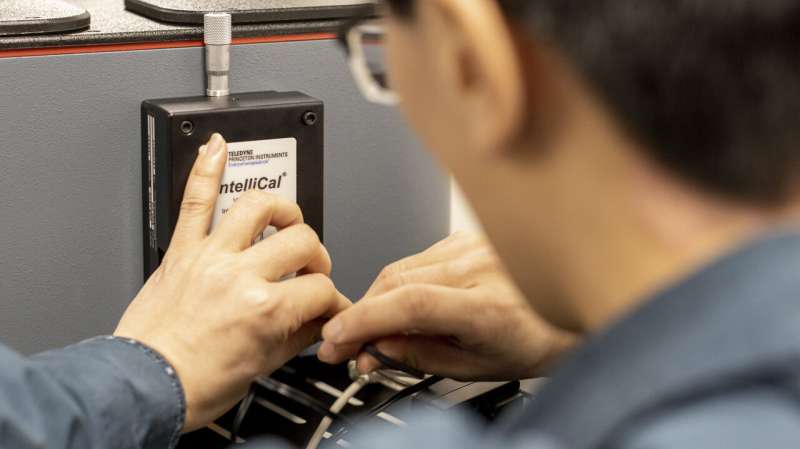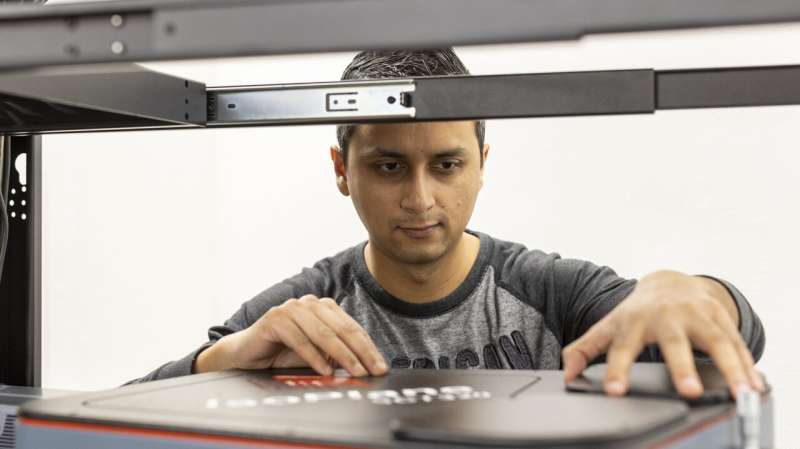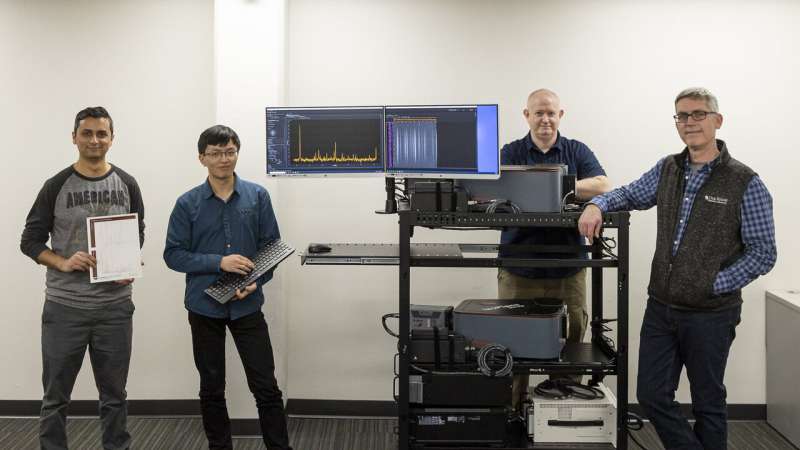University of Tennessee graduate student Zichen “Horus” He assembles a piece of a portable diagnostic imaging system that will measure plasma parameters in experimental reactors. Credit: Carlos Jones/Oak Ridge National Laboratory, U.S. Dept. of Energy
The techniques Theodore Biewer and his colleagues are using to measure whether plasma has the right conditions to create fusion have been around awhile.
The specialized lasers and off-the-shelf components they're working with are nothing new, either.
But assembling them into a portable diagnostic system that can be loaded in a cargo van and driven on a cross-country tour of experimental fusion reactor prototypes?
Biewer thinks his team will be the first to successfully do that—this summer.
Measuring plasma parameters
For about a year, Biewer, a researcher in the Fusion Energy Division at the Department of Energy's Oak Ridge National Laboratory, has been thinking of a way to build a portable system, using only commercially available components, that can accurately measure electron temperature, ion temperature, and electron density in fusion prototypes funded by DOE's Advanced Research Projects Agency-Energy (ARPA-E).
ARPA-E is funding nine projects under its 2015 ALPHA program—which, if successful, could serve as a technological basis for new reactor designs. But the agency needed a way to tell whether the plasma in the prototypes is hot enough, dense enough, and contained well enough in the magnetic field to produce fusion. In January 2019, the agency solicited additional proposals to build portable diagnostic systems to measure key parameters in these new machines. Biewer's team's proposal was selected last summer and received a little more than $1 million in funding in November 2019.
By that time, Biewer, who is principal investigator, had already researched the commercially available components for optical emission spectroscopy, a technique that uses light to measure which types of ions are present in what concentrations and at what temperatures, and Thomson scattering, which uses lasers to measure electron density and temperature by the scattering of the laser light off of the electrons in the plasma.
Postdoctoral researcher Nischal Kafle positions a component for a portable plasma imaging diagnostic device at ORNL in February. The device, a project for ARPA-E, is built of off-the-shelf parts. Credit: Carlos Jones/Oak Ridge National Laboratory, U.S. Dept. of Energy
Six months to results
Biewer said Thomson scattering is the gold standard for measuring those parameters, in part because it produces data that are useful without needing a lot of interpretation. Thomson scattering is generally performed with high-end lasers that have been adapted and built into permanent systems housed in dedicated climate-controlled buildings adjacent to the plasma reactors.
"They're very complicated systems that really do the job well," Biewer said. "But ARPA-E wanted to be able to move the system from machine to machine. So we proposed using some lasers that aren't as powerful as the ones used in these permanent systems but that still have enough energy to get the job done."
R&D staff member Drew Elliott, postdoctoral researcher Nischal Kafle, and University of Tennessee graduate student Zichen "Horus" He have been building the system on a rolling cart, assisted by instrumentation specialist Wayne Garren and He's adviser, UT professor Zhili Zhang.
Turnaround is quick. By March, Biewer hopes they will have tested the system on a plasma source in ORNL's Engineering Technology Center. By May, he hopes to have data to present at the 23rd Topical Conference on High-Temperature Plasma Diagnostics in New Mexico.
And by June, he hopes the system will be on its way to Princeton Plasma Physics Lab (PPPL) in New Jersey, boxed up in a cargo van from ORNL's motor pool, driven by his team.
From left, postdoctoral researcher Nischal Kafle, UT graduate student Zichen “Horus” He, instrumentation specialist Wayne Garren, and principal investigator Theodore Biewer of ORNL’s Fusion Energy Division stand with a portable plasma diagnostic imaging device they built. (Not pictured is R&D staff member Drew Elliott.) After the team adds a laser, the device will be ready for testing at ORNL before being taken to other experimental plasma sources this summer and fall. Credit: Carlos Jones/Oak Ridge National Laboratory, U.S. Dept. of Energy
'Have laser, will travel'
After 4–6 months testing the system on a fusion device at PPPL, the team will take it to another fusion device at the University of Washington in Seattle and test it for about the same amount of time. A trip to measure a third device is possible—"Have laser, will travel," Biewer said.
ORNL's history as a leader in fusion energy made it a prime location for a project of this sort—even amid skepticism that a portable device could produce measurements accurate enough to be useful.
"We have experience from systems built here," Biewer said. "We know what it takes, and we're in a convenient time in technology development to bring all this together in a package that we can shepherd around to these different fusion devices to measure whether they can do what we say they can.
"We have enough know-how that even if we do encounter some pitfalls, we know how to get ourselves out. You can't know everything in advance, but you can adjust to events on the fly."
Biewer's then-Group Leader, Jeff Harris, nicknamed the system "suitcase Thomson scattering," but all the systems ARPA-E is funding for this project are portable, Biewer said. What makes his team's design unique is the use of off-the-shelf components instead of custom-built or extensively adapted parts.
If it works as expected, the design ultimately could lead to a mass-produced system, or ARPA-E may continue to fund the team's research to improve the concept.
"The next design might be even better: more compact, more accurate," Biewer said.
Provided by Oak Ridge National Laboratory


























